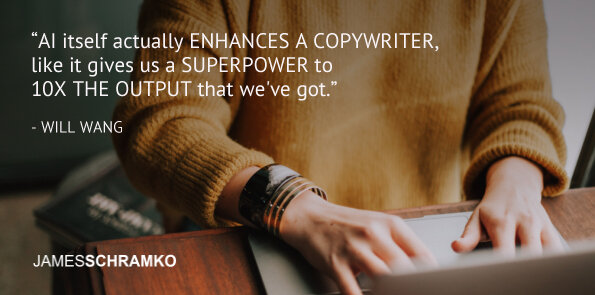Podcast: Download (Duration: 33:24 — 31.4MB)
Get Notified Of Future Episodes Apple Podcasts | Spotify | Amazon Music | Android | Blubrry | Gaana | TuneIn | Deezer | Anghami | RSS | More
Will Wang is a regular on the show, and a popular one. Last year he scored, not for the first time, one of the top ten most-watched and downloaded episodes.
This time he’s back to revisit a topic he and James have tackled before – AI copywriters in online marketing.
James and Will will discuss how AI for copywriting has developed in the past two years.
They’ll explore the kind of approach needed to use AI copywriting tools effectively.
And they’ll weigh in on the question, Will AI replace copywriters?
Table of contents
1. What two years has done for this topic
2. From the point of view of a copywriter
3. It’s the quality of the input
4. Why professionals needn’t worry yet
5. Like a muscle-bound super kid
6. Figuring out the strategy that gets results
7. It takes a number of steps…
8. Refining the output
9. The limits of the software
10. What AI can accomplish for copywriters
11. The sort of clients Will can really help
What two years has done for this topic
Two years ago on the show, James and Will discussed the topic of whether artificial intelligence can replace humans for copywriting. AI was not as popular or powerful then, and the consensus was it was far from a threat to copywriters.
Now, however, AI is becoming a more common tool in the marketer’s toolkit. Previous guests have discussed using AI in the background for ad campaigns and keynote presentations.
In the episode just before this, James and guest Ilana Wechsler built a marketing campaign on the fly using AI.
In a future episode, James plans to explore AI in relation to SEO. For now, he and Will are talking about AI specifically in the context of copywriting and marketing campaigns.
From the point of view of a copywriter
As a brilliant copywriter who’s experimented with AI, Will is well-qualified to speak on its application in copywriting.
Will is aware of the belief AI will replace copywriters and other professional services. In his view, however, AI actually enhances a copywriter’s abilities rather than threatens them.
From his experience with AI copywriting services, Will believes AI can provide a superpower to 10x the output of a copywriter.
Among other things, he has been testing the quality of output that clients using AI to write their own copy could receive. And it’s true, the technology has become far better at producing copy, especially the more data we can feed it.
From a customer’s perspective, the issue of hiring a copywriter or marketing agency to help with campaigns has become more complicated with the emergence of AI. Will asserts, however, that AI can augment the work of a copywriter rather than replace them.
It’s the quality of the input
The output of AI is only as good as the input, according to Will. Therefore, if a copywriter is good at their craft, the output from AI will still be better than what mediocre copywriters can produce.
Will believes the current use of AI in copywriting is positive, as it allows for more output in less time, enabling agencies to test and experiment more efficiently, and provide faster results to clients.
Clients will still hire agencies for their expertise in understanding the inputs and outputs of AI-generated copy, and for their ability to refine and polish the work.
Will adds that AI can bring the work up to a certain level quickly, and is an excellent tool to aid research and idea generation. It enables professionals to refine their output faster, as opposed to replacing their expertise entirely.
In this sense, AI can be likened to software tools used by architects to map out dimensions, materials and costs.
While beginners and mediocre copywriters may struggle to compete with AI-generated copy, advanced and refined copywriters can use it as a tool to enhance their craft.
Why professionals needn’t worry yet
So while AI tools can be used to accelerate output, professional input is still necessary for quality work, is what James is hearing.
Correct, says Will. He compares an agency’s use of AI to an architect’s relationship with clients, where the AI tool acts as a sandbox to which data is fed to create different outputs.
Will’s company, GrowthLabz, has so much data, it wouldn’t make sense for clients to build their own sandbox.
James agrees. In the surf industry, while software exists for shaping surfboards, it’s easier to work with someone who knows the software and can design a board based on the customer’s needs.
In the context of copywriting, Will probably has his own proprietary list of prompts for the AI tool he uses. This acts as an algorithm to get the best possible outcomes while taking into account the software’s limitations.
Although the AI tool can mimic someone’s voice or style, it still needs professional input. It acts as a supplement to the professional’s work, rather than a replacement.
Like a muscle-bound super kid
Will uses the metaphor of a superpowered three-year-old to describe the current state of AI. While the tool can do amazing things, it still needs guidance and input from humans to understand what’s right or wrong and how to handle contextual information.
James compares it to a magic wand that needs a masterful wizard to control and use it for the best impact.
As an agency, GrowthLabz know how to use AI tools for the best results. And to quote Dean Jackson, it’s the who, not the how – instead of trying to figure out the tool, clients are often better off finding an expert to build campaigns strategically and effectively.
Are there any agencies pretending they still don’t use AI, asks James?
Will doesn’t know. But the fact that non-marketing people are talking about AI is an indication that it’s prevalent in everyday life and is becoming mainstream.
Figuring out the strategy that gets results
James has been using GPT3 and realizes the right prompts can get you really good results in terms of material. Understanding the bigger picture, however, is key.
He and Will caution against getting bogged down in single tactics. They highlight the need for a clear strategy that targets the right audience and addresses the real reasons why people buy a product.
It takes a number of steps…
As far as producing usable copy, Will has found a methodical process is in order. He typically breaks down a copywriting task into 10 to 15 prompts.
The initial prompt to the AI must be well-contextualized, or it will generate irrelevant output. You can’t, for instance, say simply, Write me a long-form sales page to sell my consulting services.
You might, instead, start from the beginning and ask for ideas, benefits or pain points.
The AI can generate a list of topics on demand, which then must be narrowed down and honed in on with additional prompts to create more targeted content.
Ask the tool, for example, to tell you more about the points that are relevant to your campaign, like business growth.
An AI program like ChatGPT can also provide examples if asked to, and some of the information it generates can be quite impressive.
An interesting thing is, the step-by-step approach is something both Will and previous guest Ilana Wechsler arrived at independently, but which was likely influenced by their common background in data analysis.
Refining the output
At some point, says Will, you will have a massive amount of writeup from the tool. That’s when you start refining the output.
This is also where it takes some expertise and nuance in determining which parts of the output are useful and which are not. Will explains that this is where pattern recognition and experience recognition come into play.
Will often cuts out parts that don’t make sense or sound human, and prompts the AI to rewrite them.
It’s also important to consider the tonality and audience of the writing – this requires experience and familiarity with the brand guidelines. Will might ask the AI to make the writing more friendly or formal depending on the need.
The limits of the software
While AI can help save time writing the first draft of copy, it still requires human intervention to add emotional nuances, contexts, and other subtleties that the technology cannot yet fully grasp.
Currently, AI also lacks the data points to determine what makes great sales copy, including an understanding of human psychology and niceties of feeling. However, the technology is advancing rapidly, and it’s only a matter of time before AI can generate higher quality copy on its own.
What AI can accomplish for copywriters
The use of AI in copywriting has not so far replaced human writers but has instead enhanced their output. By using AI tools, copywriters can save time and generate working drafts, allowing them to focus on editing and refining their content.
This process enables copywriters to produce more campaigns in less time, ultimately benefiting both the agency and the client.
AI has not only made an agency like GrowthLabz more efficient, but it has also made it more valuable to clients.
By focusing on client results and using performance-based metrics, agencies can demonstrate their value and differentiate themselves from their competitors.
Although AI has not replaced copywriters, it has become a valuable tool for boosting their production and improving their workflow. A large benefit is that no copywriter will ever have to stare at a blank screen again.
The sort of clients Will can really help
It’s worth asking, says James: what type of client is getting a good result with Will?
Will’s company typically helps two types of clients: larger businesses that generate $20-50 million a year, and small businesses earning around $300,000-$500,000 annually. Growth Labz reengineers the marketing and offers of these smaller businesses to get them to a million dollars a year.
Interested clients can contact Will through GrowthLabz.com, or find him Will Wang, on LinkedIn.
As a parting message for listeners, Will highlights the importance of leveraging technology to gain a competitive advantage. While AI may not yet fully understand sales psychology, using technology can help accelerate results – where the human touch comes in is in creating the right content at the right time.
Liked the show? Leave us a review on iTunes













Leave a Reply